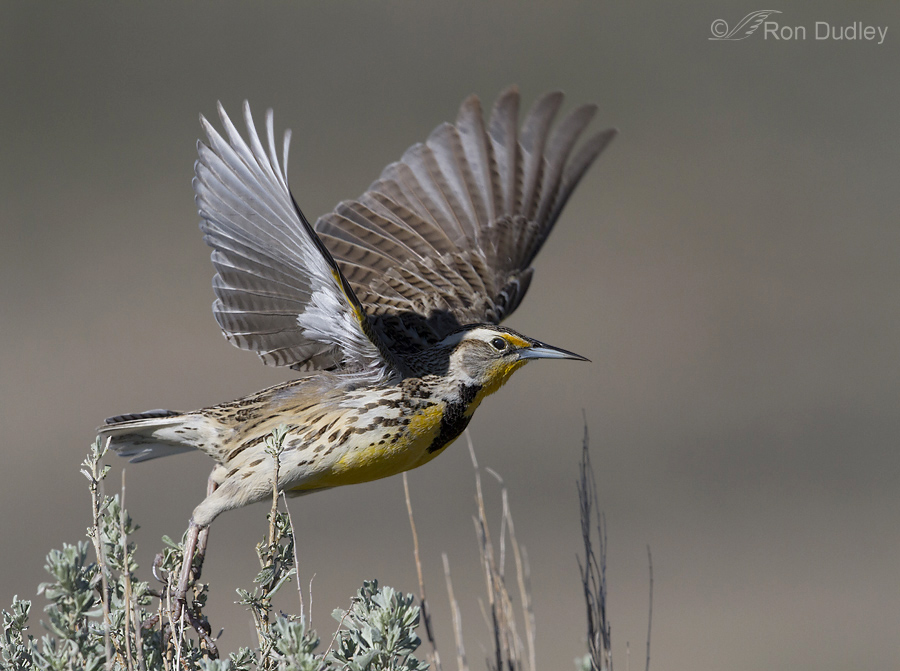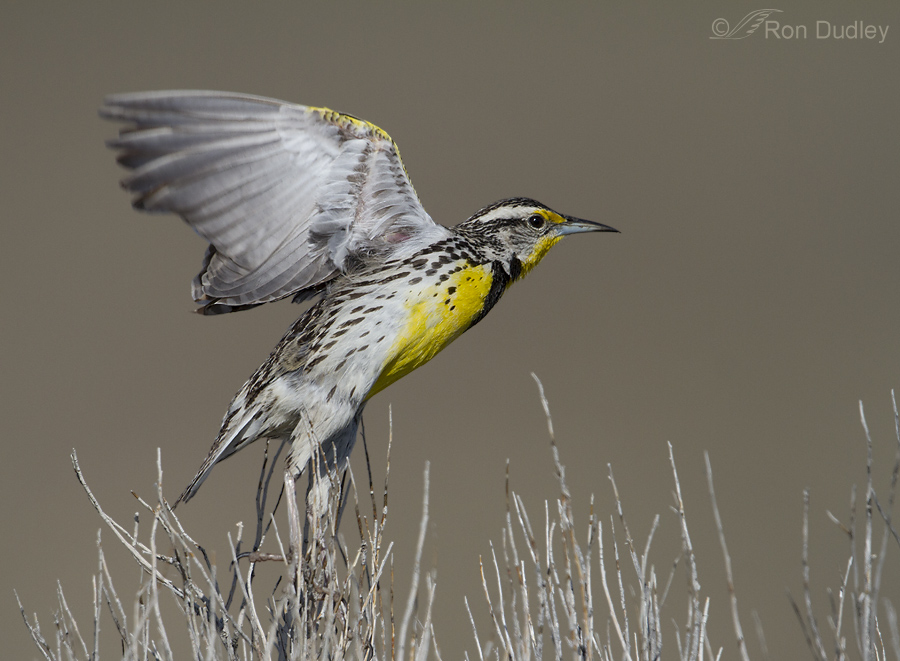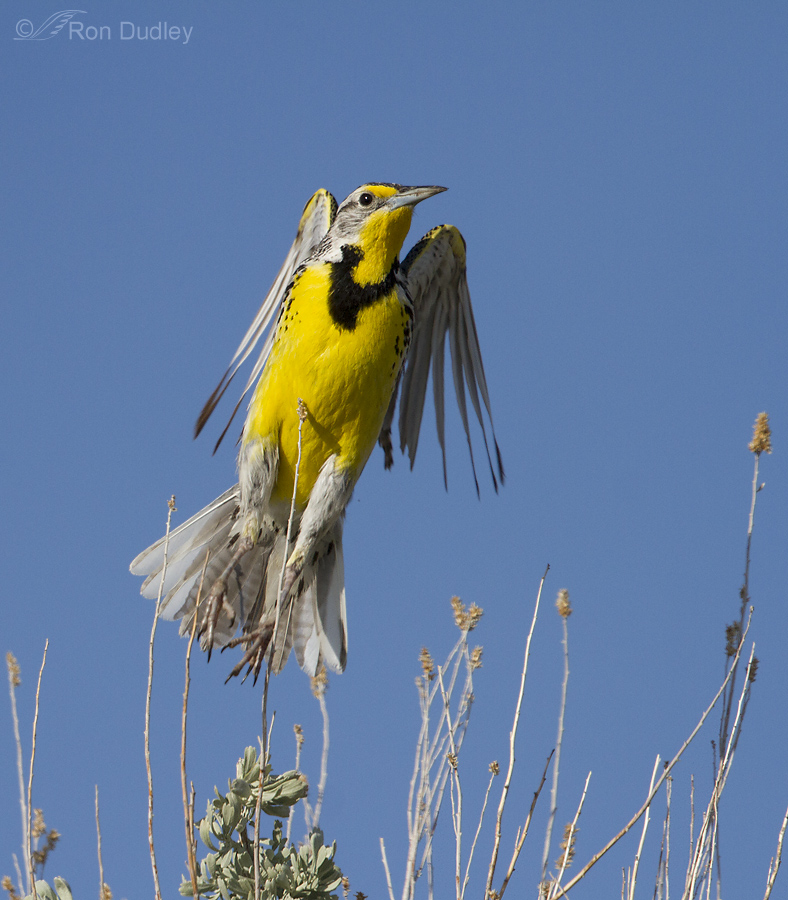Avoiding “clipped” body parts is perhaps the biggest challenge associated with take-off shots.
Take-offs are lightening fast, especially with relatively small songbirds and if you’re close enough to get good detail they’re often completely out of frame before you can trip the shutter. Once you develop your skills (and reflexes) you may be able to keep most of the bird in frame with only a few body parts cut off or clipped but of course the goal is to not only get the entire body in frame but to also have enough room around the bird for pleasing composition. It isn’t easy!
If you can anticipate angle and direction of take-off your chances of success are greatly enhanced. Doing so is highly variable, depending on many conditions. Here’s some examples: (each of these shots was taken on Antelope Island last week)
Western Meadowlarks are very common on Antelope Island right now and I get a lot of practice with them. Birds are most likely to take off in the horizontal direction that they’re facing but then you have to worry about the “vertical direction” – will they take off from an elevated perch going up or down or level and at what angle? Sometimes their perch helps you to guess correctly more often.

1/5000, f/6.3, ISO 500, Canon 7D, Canon EF500mm f/4L IS II USM, not baited, set up or called in
The favorite perch of meadowlarks on the island is the tops of sagebrush which often have vertical bare twigs from last years growth surrounding the bird. Those twigs must be avoided at launch. Here there are few twigs and they’re not very high so I anticipated that the meadowlark would take off in the direction it was facing (to my right) and that the angle to vertical would be almost level because that direction was clear of twigs (the more vertical the direction of take-off the more work required). I guessed right and got a shot I like without clipping anything and with enough room in front of the bird for decent composition.

1/3200, f/6.3, ISO 500, Canon 7D, Canon EF500mm f/4L IS II USM +1.4 tc, not baited, set up or called in
When it was perched this meadowlark had lots of twigs around it in every direction and they were sticking up fairly high so I figured it would take off at a steeper angle than the previous bird – which it did. Again, nothing clipped or cut off and there’s enough room for composition.
Some might also notice the scarcity of feathers just above the “armpit” – something I covered with this species in a previous post.

1/4000, f/6.3, ISO 500, Canon 7D, Canon EF500mm f/4L IS II USM +1.4 tc, not baited, set up or called in
This meadowlark had been perched on the green branch at bottom with very long twigs sticking up around it. About the only direction it could go was up so I aimed my lens above the bird and waited. Through the viewfinder I could only see the top half of the bird but the timing for this shutter click was just right. It’s a bit of an unusual flight pose but I enjoy it for its variety.
I realize that most of my readers are likely more interested in the images themselves than they are in the technique used to get them but some readers are also bird photographers and occasionally I like to do this kind of post.
Happy Easter, everyone!
Ron


Wonderful images…as usual. As barely more than a point and shoot “photographer”, most of the technicals stuff you share is light years over my head, by put, even I’ve benefitted by your gracious sharing and tips…
Welcome back Patty. I have missed you. And I hope you had a wonderful time away.
I like it when you share your techniques. Very interesting and shows how patience and paying attentions is rewarded. Thanks.
Hi Rod,
As always I appreciate your pictures. I also try to take bird pictures and I really appreciate you secret info. Thanks for sharing.
Len
Ooooh — I love that third image, especially! Thanks for the interesting technique info and a very happy Easter to you, too 🙂
Sensational shots and great talent! Thanks for sharing Ron!
Charlotte
Love them all. And the experience, the knowledge, the perseverance, the patience (and the frustrations) which go into your bringing us these daily glories.
Mind you, I think the smaller lbjs make greased lightening seem slow and predictable. Even I can make semi-educated assumption about which way a corella for example will take off. Sparrows and pardalotes? Luck. Or lack of it, almost every time.
You’re right, Elephant’s Child – lady luck usually plays a significant role in all of this. That’s why, if you shoot enough shots, you’ll eventually get what you’re after. Maybe…
Ron:
I’ve often wondered about the autofocus settings you use for your exceedingly sharp take-off shots. I don’t speak Canonise, so perhaps Mia can translate. With Nikon, you can set continuous autofocus mode so that the burst continues whether or not the camera thinks the image is in focus. Alternatively, you can set it so that when you hold the shutter button down, it only activates the shutter when the camera decides the subject is in focus. A related point/question concerns the number of points you use for acquiring focus. These questions are sorta related to the topic of your blog today.
Dave
Dave, Both of my 7D’s are set so that a burst continues firing whether focus is locked on or not. Generally though, for these kinds of shots I prefocus on the bird and then take my thumb off the backbutton (where I have AF assigned to) and hope the bird takes off laterally to me so that it will still be in the same plane (and as sharp) as when it was perched. After all, if it doesn’t I typically wouldn’t have a very good angle on the bird anyway.
For takeoff shots I have one AF point assigned to get the sharpest focus-lock on the eye before takeoff as possible. For most flight shots I have 5 AF points assigned (a cluster at center) but if a background other than sky is close to the bird I generally just use one active AF point. As you know, backgrounds like that can easily grab AF and the single active AF point seems to allow that to happen less often.
Thanks for the info. That is the same strategy I use. But I’ve been getting a number of shots immediately after take-off that are not critically sharp. I probably need to do a check on myself to make sure I’m actually implementing the strategy I think I’m using. Sometimes my mind and body don’t realize they are in disagreement!
I get some of those shots too, Dave. Comes with the territory. Do you have enough shutter speed?
Great take-off shots! I’ve done a poor job of anticipating with two species in particular: scissor-tailed flycatchers and more recently the prairie chickens. The flycatchers usually are sitting on a wire but give very little indication of when or the direction of take-off. With the chickens, I seriously underestimated the extent of the vertical leaps during the male dominance “dance”. I would love to have another shot at the prairie chickens.
Thanks, Dave. I’d like to have my FIRST chance at Prairie Chickens one day…
Ron, I rarely comment but want you to know that I count on you for my daily dose of wonder! Your photos are always magnificent. I came across this extraordinary story from the BBC about a young girl in Mongolia who hunts with a Golden Eagle, and think you will enjoy it. Here’s the link: http://www.bbc.com/news/magazine-26969150
Harmony, I actually saw that BBC story yesterday but I enjoyed seeing it again. Thank you.
Happy Easter Ron. And thank you for the technique lessons. I always learn something from them.
I’m glad they’re helpful to you, Jorge. Thanks.
Thanks Ron! I love this kind of post. Your tips have helped me SO much. Beautiful images of beautiful birds.
A very happy Easter to you, too!
Thanks very much, Sharon.
Happy Easter Ron. Love the images and really appreciate the technical info. Makes me a better photographer.
Good, Ellen! Glad to hear it.